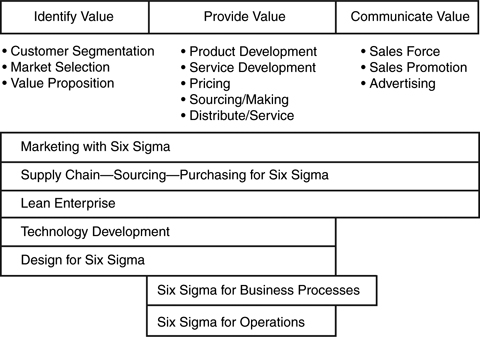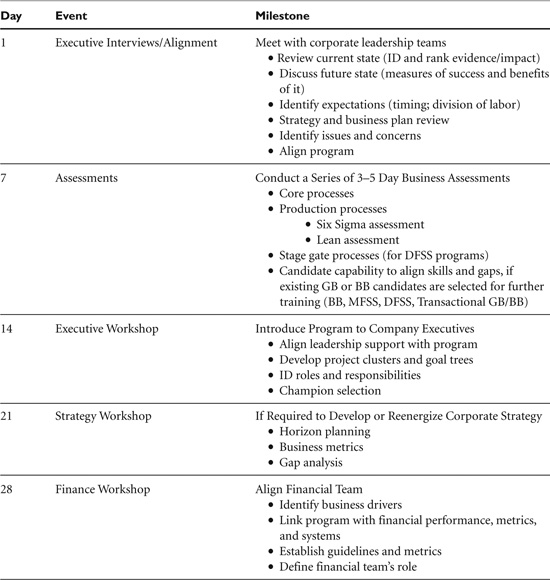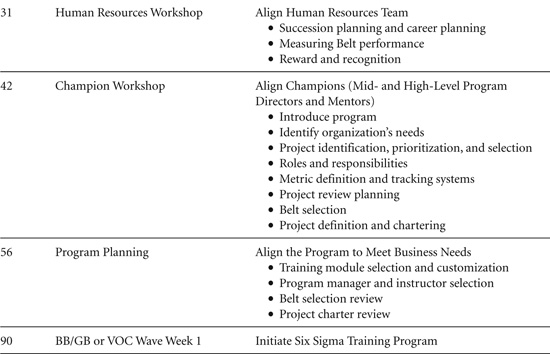7. Defining the Six Sigma Project Scope
With Dan Kutz
We now commence the first 90 days of your Six Sigma deployment. A sizable front-end portion consists of the process of planning the deployment. When doing a quick review of the activity that must be initiated, one can clearly understand the important of good upfront thinking and planning. The following list shows at least 14 different milestones that must be addressed during the initial stages of the deployment. Determining the scope of the deployment generates the milestones that must be accomplished for the deployment. There is a huge difference between the milestones for a small pilot deployment versus a large corporate-wide deployment.
1. Establish the Six Sigma leadership team.
2. Identify Corporate Critical Ys (metrics) and set goals.
3. Identify the timeline for deploying.
4. Black Belts: Operations, Services, Product Development.
5. Green Belts: Operations, Services, Product Development.
6. Implement project tracking system.
7. Identify potential projects linked to Critical Ys.
8. Identify Champions and Black Belt candidates.
9. Prioritize the projects and assign to the appropriate Black Belts(s).
10. Complete a charter for each project, including financial impact.
11. Define the project review methods and frequency for your business and plant or area.
12. Resolve if the resources and leadership commitment are in place to make the project(s) successful.
13. Determine the communications methods for your plant and business.
14. Develop reward and recognition guidelines.
The first element of the deployment is the scope of the Six Sigma deployment over the next 12 months. The first milestone of the deployment philosophy is to establish the business case first. Six Sigma—especially when including Lean Enterprise—includes many different business applications. The three usual applications include (1) manufacturing operations; (2) business process support; and (3) new product development.
That does not include other areas like marketing, sales, supply chain management, safety, and enterprise systems. So, deciding what the scope of the Six Sigma deployment is and where the focus will be is critical at the onset of the deployment. Therefore, different processes use different forms of Six Sigma and their outcomes:
• Transactional Six Sigma for business processes: Optimizing process flow and accuracy.
• Operational Six Sigma: Optimizing product and process flow and accuracy.
• Lean Sigma: Products and special tools for process flow.
• DFSS (Design for Six Sigma): New products, operations, and market windows.
Six Sigma can easily move from a focus on one function (e.g., manufacturing) or to a comprehensive business-wide focus to include all functions. Also important are deciding whether the effort is a pilot effort, what to do about overseas operations, whether to do part of the company or the whole company, or how to interface Six Sigma with preexisting or ongoing initiatives.
Connecting Six Sigma to Other Initiatives
Connecting Six Sigma with Earlier Initiatives. Every company has a history of launching numerous initiatives—some successful, some not. Every company has established great programs in the past. The goal is to dovetail Six Sigma with the past good things and not bill Six Sigma as a replacement to those past accomplishments. For example, a company has implemented a good TQM program in the past; this company can pitch Six Sigma as the natural extension of the TQM program that adds advanced tools and methods to the effort. This approach acknowledges the good work done by the company in the past.
To effectively link Six Sigma to other initiatives, there might be a requirement to customize the Six Sigma approach to incorporate the tools and terminology of past successful programs. For example, AlliedSignal under Larry Bossidy had successfully launched Total Quality Leadership (TQL) and Total Quality for Speed (TQS) before it launched Six Sigma.
To allow those two initiatives to support Six Sigma, AlliedSignal chose to name their Six Sigma program Operational Excellence. During the initial pitches, great care was taken to demonstrate how Operational Excellence would build on the tools and methods learned in TQL and TQM.
3M had also done a lot of work in quality before their Six Sigma launch. There was great care to establish customization teams from 3M to work with the external consultants in customizing the 3M Six Sigma approach. This way, there was a direct link between Six Sigma and previous initiatives.
Effectively dovetailing your Six Sigma program with prior initiatives sends the message to your company that you are trying to extend and optimize the good work of the past. If you disregard past initiatives, Six Sigma might look like it’s replacing a lot of things that were working fine already. That can lead to frustration and confusion among your troops. Six Sigma will be placed at the risk of becoming the infamous program of the month. Also, effective dovetailing helps the impending change not look quite so radical, because it simply extends old ideas.
One company we worked with had a marginal TQM program that they were never really happy with. They dovetailed Six Sigma into that by saying that Six Sigma was putting the brains back into TQM. Harsh, granted, but they were acknowledging that the TQM program left a lot to be desired, and that a lot of the concepts were important enough to get more advanced methodologies.
Connecting Six Sigma to Current Initiatives. When launching Six Sigma while other initiatives are currently underway demands a need for initiative coordination. For example, we had one client launching an SAP deployment at the same time as a Lean-Six Sigma deployment. They folded Lean techniques directly into the SAP deployment. That made sense because SAP automates business processes and Lean streamlines business processes. To streamline and simplify business processes before automating them was logical. I have a mantra for business process improvement: Simply, Standardize, Automate.
The other option is to make the choice to delay Six Sigma until the other initiatives are completed. We’ve seen potential clients do that, especially if they are in the middle or just beginning an SAP deployment. Because all initiatives require resources to be successful, the decision should focus on whether you can resource the initiatives you have on the table.
If the decision is to deploy Six Sigma while other initiatives are in progress, the communication of this should acknowledge that numerous initiatives are being executed and explain how these initiatives relate to the company’s vision and mission. All these initiatives are essential to the future success of the company.
I watched Larry Bossidy confront this issue with some of his leaders. There were several initiatives in progress while Six Sigma was deployed—there was a subtle cry of “initiative overload.” When asked about the overload, Larry asked, “If our vision is to be a premier company, which initiative should we stop?” The silence was deafening, and the point was made. To be excellent requires a lot of hard work from a lot of people.
Pilot or Full Deployment?
There seems to be a common question before a new initiative: “Should we do it corporate wide or on a small scale (pilot)?” Either approach is correct, depending on the company. Strong corporate leaders such as Jack Welch, Larry Bossidy, Ed Breen, and Jim McNerney each launched Six Sigma across the corporation.
The concept of a small pilot didn’t even enter their minds. However, numerous companies—such as 3M, Rohme and Haas, Johnson & Johnson, and Tyco—did start with pilot projects, which ultimately lead to corporate-wide programs.
Pilot Programs. Pilot programs serve the purpose of proving the concept. The advantage is that if the concept is wrong, the damage is contained in a small area of the company. However, if the concept is right, then the whole company has lost a significant amount of time to deployment and results. Programs of the month often start off as pilots, so you have that stigma to compete against. Also, pilots can be construed as leadership hesitancy for the program.
As you probably gathered, I’m not always in favor of pilots. But I have seen pilots work and be the right thing for some companies to do. The chief risk is that Six Sigma is launched by training a bunch of Black Belts, but their projects are poorly defined, the right resources are not available, and no one is truly accountable for the success or failure of the pilot. Pending a pilot Six Sigma launch, the pilot must be launched as a mini-deployment to include the same milestones as a corporate-wide deployment.
These are the 14 milestones presented at the beginning of this chapter. Without providing the Six Sigma pilot effort full support, you are dooming the pilot to failure. In addition, the infrastructure and methods developed in the pilot will probably be used in the corporate deployment. Customization of the Six Sigma training material will be much easier because you can use the data from the pilot to support the Six Sigma concepts.
Full Deployments. Full corporate-wide deployments have advantages that are apparent if the company’s leadership takes the deployment seriously. However, the risk of a full deployment is that full deployments take huge top leadership commitment, which translates to a lot of time. The prelaunch deployment plan is required to be complete, detailed, and well disseminated. The training requirement, even for the first 90 days, is extensive. To add to the complexity, a full deployment is multifunctional. And finally, new positions created from the necessity to drive the program must be staffed.
The advantages of a full deployment are many. First, because the business case should drive the scope of the deployment, establishing the scope of the Six Sigma program to address the gaps in the external realities is possible. Company leaders are involved in the decisions concerning accountability and expectations at the onset. And, a company can expect a great ROI within six–eight months. The corporate culture is positively changed because of results, recognition, and rewards. You will have followed Kotter’s eight steps (see Chapter 3, “Six Sigma Launch Philosophy,” for detail) and reaped the benefits quickly.
Full deployments rely on the organization knowing what’s going on. The corporate leadership has the window to systematically link their strategy to the annual operating plan and to Six Sigma projects simultaneously. So, the vision of closing gaps is now possible with a full deployment.
The risks of the full deployment are small. The first risk is that not all of the senior leaders will be on board for the deployment. CEOs like Welch and Jim McNerney resolved that by not letting Six Sigma be an option. But not all CEOs are willing to take that stance. The deployment will require vast amounts of time, so the risk is, Will your leaders be willing to spend the time? Rigorous and systematic program reviews during frequent visits around the company will tell the tale of commitment.
The history of Six Sigma shows that full deployments achieve results in order of magnitude well above pilot programs. If you want to change the culture, change the culture—it’s as simple as that!
By Business Unit or Division?
Although full deployments are recommended, the reality is that full deployments are never completely full. Generally, most of the company is participating in Six Sigma, but not all of the company is taking part. For example, a new acquisition may not be ready to participate because they are still trying to transition from the old way of doing things to the new way of doing things.
So the question is, Do you select certain business units to start or entire divisions to start? The advantage of starting with some, but not all, of the divisions is that you gain some of the advantages of a full deployment and some of the advantages of a pilot deployment simultaneously.
Launching a Six Sigma deployment by division is probably less risky than launching by business unit. Because a division’s organization and behavior are close to that of the entire corporation, each division represents a full deployment across all its business units. Each division creates the infrastructure it needs to drive the program forward.
If the launch is business unit by business unit, each business unit becomes its own micro corporation. The deployment roadmaps, the support infrastructure, the priorities, and the expectations will be unique from business unit to business unit. It will be quite a mess to try to standardize across divisions after the business units have gotten started. Going business unit by business unit will also end up costing more money in consulting because of numerous individually defined programs.
The wildly successful deployments of Six Sigma have had a small but centralized organizational infrastructure. For example, I lead the Six Sigma effort in the $4 billion engineered materials sector of the old AlliedSignal. I was definitely a sector HQ resource, and my staff only consisted of three or four Master Black Belts and some administrative assistance.
All other resources were decentralized and belonged to the divisions and business units. The advantage of the centralized office was the highly efficient coordination of the effort. We would ensure that all divisions and business units used the same project tracking system. We organized the annual training plan for Black Belts to foster efficiency and cost effectiveness. We standardized certification requirements for Master Black Belts, Black Belts, and Green Belts and maintained a sector register of those people who were certified.
In any large company, there will exist some business units that just don’t want to play. These are usually the business units that are doing well and really don’t think they need the help. I had one of those business units in my sector that just didn’t play. I was upset about it, but my boss, Donnee Ramelli (who is now President of GM University), told me not to worry about it. That particular business unit accounted for less than 5 percent of the sector’s revenue, and all the other business units were playing hardball. So, make sure that the divisions and business units that account for the highest business impact on the company are in the game. The others will come on board soon enough.
Deployment Domestically or Globally?
Global companies always have to face the question of when to deploy Six Sigma outside their domestic boundaries. This was especially true for Honeywell, GE, 3M, and Tyco. To drive a successful global Six Sigma deployment is wrought with issues such as culture differences, language differences, and economic differences, to say nothing about logistic difficulties. The choice, of course, is whether to launch globally simultaneously or to use a phased approach to address the global nature of the company.
Considering the complexity of the global environment, it makes sense to get your ducks in a row domestically before going global. That way, the experience gained can be readily leveraged in the global arena. You have experienced many of the failure modes and worked through them. Your training material has been customized and is mature. And, you have a critical mass of experienced people who can aid in the global deployment.
However, speed is of the essence as you perform a phased deployment plan. Your global units may feel slighted if they have to wait too long for Six Sigma. It’s best to bring the global players on board within months after the domestic launch. Also, you can involve global players right from the beginning by sending them to domestic training events. I had several students from Europe and Asia in my U.S. classes, and it worked out great.
Leadership training can be initiated as soon as the training material has been translated. You can give aggressive global leaders a head start and support this way. You really have to dovetail the deployment globally the way the culture will accept.
The global plan is documented in the overall Six Sigma deployment plan so everyone knows what is going to happen. The longer you wait to go global, the more you miss out on business results. I saw a German Black Belt improve capacity by 50 percent in a sold-out market in four months. That yielded millions of dollars for the corporation.
Six Sigma Program Content
Because Six Sigma has such a wide range of applications, the focus of the program for the first three years should be established. Many companies focus the first year on manufacturing, the second on product design, and the third on business processes. Again, the program content should directly address your external realities.
Integrating Lean Enterprise. Recently, I am seeing more and more companies integrating Lean methods with Six Sigma methods. This, of course, is a wise thing to do because Lean focuses on speed and flow and Six Sigma focuses on accuracy and removing variability. Both efforts work well hand in hand. I have seen the failure mode of a company trying to launch Lean and Six Sigma as separate and parallel initiatives. The result has often been the creation of two competing camps, with each camp trying to lay claim to the other camp’s results.
It turns out that the companies that launched the two methods as Lean Sigma have been successful. In fact, for some companies, it is best to start with Lean training, get quick results, foster enthusiasm, and then bring in Six Sigma. A company can do quite a few Lean Kaizen events based on a manageable level of training. The team aspect of Lean carries over directly into Six Sigma projects.
Because the focus of both programs is process improvement, they work very well in ensemble. Six Sigma offers tools and approaches that Lean doesn’t, and Lean offers tools and approaches that Six Sigma doesn’t. By combining the two initiatives into Lean Sigma, you end up deploying a wide variety of tools to a wide variety of people. These people have learned to use the right tool in the right place. There are no competing camps, just the competition of the market place. Fast, dramatic results rule each day.
The last way to incorporate both methods is to launch Lean and Six Sigma one at a time. By doing that, you tend to lose the integration of the two, and you tend toward different infrastructures to drive each one. By launching both at the same time, you can launch off the same infrastructure and the same tracking methodology. These grand efficiencies rule the day.
Other Six Sigma Programs. There are an exceptional number of Six Sigma programs, of which all or some may be launched. Figure 7.1 shows a high-level description of where Six Sigma plays in the process of identifying value, delivering value, and communicating value. The most popular program is Six Sigma for Operations. This program is associated with the birth of Six Sigma at Motorola. This program is aimed directly toward manufacturing operations. For manufacturing companies, this will always be the program to be included in the first year of deployment.
Figure 7.1 Six Sigma programs, as related to identifying, providing, and communicating value.

The MAIC (Measure, Analyze, Improve, Control) roadmap is the heart of the program. The operations program is driven by metrics that represent quality and cost improvement, as well as improvements in speed, capacity, and productivity. The Operational Six Sigma program can include many courses such as supply chain management, equipment reliability, process measurement systems, and Lean methodologies.
The next popular program is Design for Six Sigma (DFSS). While the Operational Six Sigma drives bottom-line growth, DFSS drives top-line growth through the efficient development of new products and services. Although the sense of DFSS is that it is aimed at technical resources, a comprehensive DFSS also includes sales, marketing, and technical development. A large part of DFSS includes programs addressing the voice of the customer along with the technical product development tools that are necessary to create and launch a new product into the marketplace.
A relatively recent program in Six Sigma is Transactional Six Sigma. This very important program addresses business process improvement or business process development. Software development is also included in this area. Because transactional processes are very different from manufacturing processes, a different roadmap and set of tools are needed.
With Transactional Six Sigma, Six Sigma can literally be driven into all parts of the company. For example, just the legal department in a corporation has control of over 45 different processes. Just think of the number of business processes you manage (or try to manage) across your company. There are probably 2,000 or more processes your people manage.
To get Six Sigma started on the right foot, a series of assessments are recommended. There are several assessment areas to include, such as operations, technology, and business processes. These assessments are valuable because they give a database’s status on what’s working and what’s not. Assessments are a great way to establish strengths and weaknesses and to develop initial Six Sigma project lists.
Scheduling Events
With any Six Sigma deployment and especially a deployment that is widely scoped, there are a very large number of events that are to be scheduled. This is one of the major functions of a centralized Six Sigma group within a company. The following table gives a partial Microsoft Project output for an early Six Sigma deployment. Listed are the events and the number of days necessary. The actual file includes start dates and resources. There are several scheduling and logistics pitfalls:
1. Notifying the participants too late.
2. Not considering holiday schedules.
3. Not planning for transfer of responsibilities.
The requirement to meet before deploying Six Sigma is to understand the scope of the deployment. Considering the options and how those options relate to the company and its external realities well in advance of the kickoff will help solidify and clarify Six Sigma and how it fits into your big picture. Six Sigma is complex but can be made simple with the right upfront considerations. Table 7.1 gives you some idea of the number of events and timing to get to your first extensive round of Six Sigma training within the target 90 days.
Table 7.1 Deployment Milestones for the First 90 days of the Six Sigma Deployment


